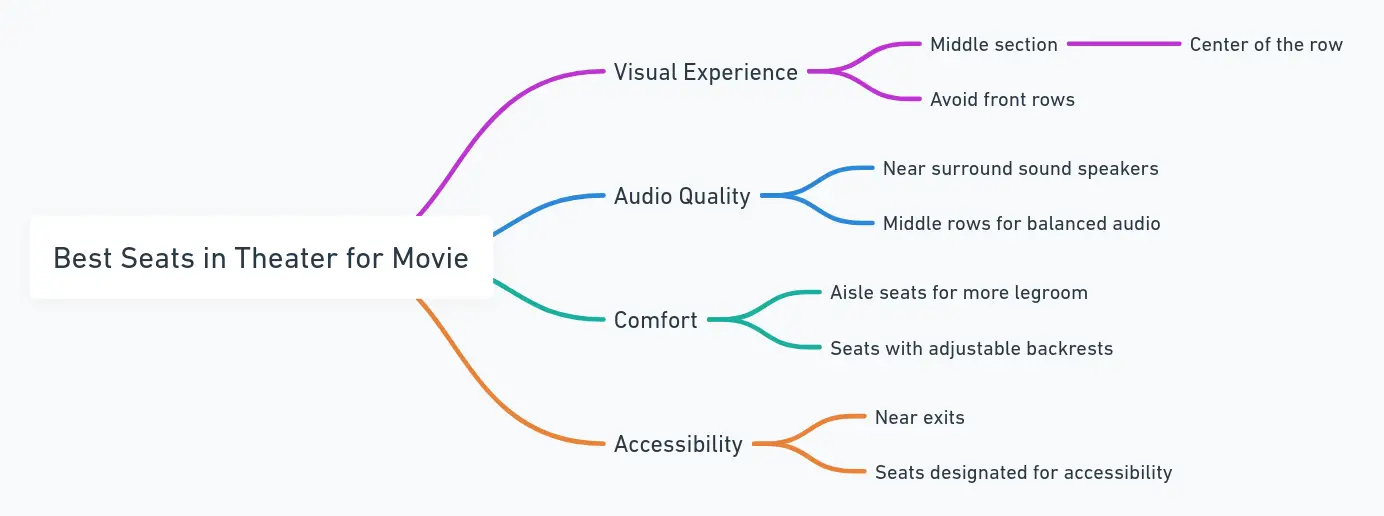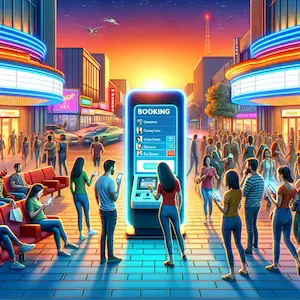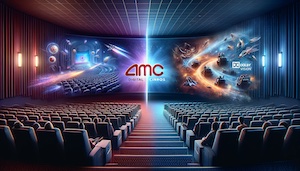Embarking on a cinematic journey at your local theater is about more than just watching a movie; it’s about immersing yourself in a visual and auditory experience that can transport you to another world. However, the quality of this experience can be significantly influenced by where you sit. With the advent of advanced screening formats like IMAX and enhanced sound systems such as Dolby Atmos, choosing the right seat has become an essential part of planning your movie outing.
This comprehensive guide is designed to help you navigate the nuances of theater layouts, sound quality, viewing angles, and personal preferences to ensure you find the best seat in the house. Whether you’re a casual movie-goer or a cinephile, understanding how to select the perfect spot can elevate your viewing experience from good to unforgettable. Let’s dive into the art of choosing the best seats in the theater for a movie, ensuring your next visit is as enjoyable as possible.

Table of Contents
Overview of Best Seats in Movie Theater

Understanding Theater Layout
When it comes to selecting the best seats in a theater for a movie, understanding the layout is crucial. Theaters are architecturally designed to enhance the viewing experience, but not all seats are created equal. The layout of a theater includes the types of screens and seating tiers, each playing a significant role in your overall experience.
Types of Screens
The first thing to consider is the type of screen your theater offers. Theaters may have standard screens, larger-than-life IMAX screens, or even 3D and 4DX options. The size and technology of the screen affect where you should sit for the optimal viewing experience. For example, IMAX screens are much larger and taller than standard screens, requiring you to sit further back to take in the entire scene without moving your head. On the other hand, smaller screens might allow for a more flexible seating choice without compromising on the visual experience.
Seating Tiers
The seating arrangement in a theater is typically divided into tiers or sections. These can include the front row section, middle section, and back section, each offering a different viewing and auditory experience. The front section, often the least desirable due to the need to tilt your head upward, can still offer an immersive experience for those who enjoy being “in” the action. The middle section is generally considered the prime location, providing a balanced view of the screen without the need to tilt your head or strain your eyes. The back section, while farther away, offers a panoramic view of the screen and is preferred by those who wish to take in the entire scope of the movie without disturbances.
Understanding the theater layout, including the types of screens and seating tiers, is essential for choosing the best seat. The goal is to find a spot that offers a comfortable viewing angle, excellent sound quality, and an immersive experience that enhances your enjoyment of the film. Whether you prefer the immersive experience of sitting close to the screen in an IMAX theater or the balanced view from the middle section of a standard screen, knowing the layout can help you make the best choice for your next movie outing.
The Best Seats for Sound
Achieving the perfect auditory experience in a theater is just as important as finding the ideal viewing spot. The sound design of a movie can significantly enhance the storytelling, enveloping you in a more immersive cinematic experience. To optimize this aspect of your movie-watching, understanding how theater acoustics and speaker placement affect sound quality is essential.
Acoustics and Speaker Placement
Theaters are designed with acoustics in mind, aiming to distribute sound evenly throughout the space. However, the experience can vary depending on where you sit. Speakers are typically placed around the theater, including the front, sides, and back, to create a surround sound effect. Sitting too close to one set of speakers might result in a skewed audio experience, where the sound from that direction overwhelms other audio cues. Conversely, sitting too far back or in certain corner seats might distance you from the optimal sound field, making the audio seem distant or muffled.
The Sweet Spot for Audio
For the best balance of sound, you’ll want to find the “sweet spot” in the theater. This is typically located about two-thirds back from the screen, in the center of the row. Seats in this area benefit from the designed acoustics, receiving an equal blend of sounds from all directions. The central location ensures that the audio arrives at your ears simultaneously, creating a cohesive and immersive auditory experience. This spot is particularly crucial for films where the soundtrack and sound effects play a significant role in storytelling, allowing you to catch every detail.
Moreover, modern theaters often feature advanced sound systems, such as Dolby Atmos, which create a three-dimensional sound experience. These systems add height to the sound, making audio seem as if it’s coming from above, as well as all around you. Sitting in the sweet spot maximizes the potential of these systems, allowing you to truly feel at the center of the action.
In summary, while personal preferences can vary, aiming for the middle section and avoiding extremes in proximity to speakers can significantly enhance your auditory experience in a theater. Remember, the goal is to be enveloped by sound, not overwhelmed or underwhelmed, making the choice of seat for sound just as crucial as for viewing.
The Best Seats for Viewing
Finding the best seats for viewing in a theater is key to maximizing your cinematic experience. The visual element of a movie is paramount, as it conveys the story, emotions, and atmosphere. The right seat can make the difference between merely watching a movie and being fully immersed in it. Let’s delve into how angles, distances, and choosing between center and periphery can impact your viewing experience.
Angles and Distances
The optimal viewing angle in a theater is one that allows you to take in the entire screen without having to move your head too much. A slight upward gaze is generally comfortable, but being too close to the front can force you to tilt your head uncomfortably, leading to potential neck strain and a distorted view of the action. Conversely, sitting too far back can diminish your sense of immersion and make the screen appear too small.
The best viewing distance is one where the screen fills your field of vision, allowing you to capture both the sweeping landscapes and the subtle expressions of characters without scanning back and forth. A good rule of thumb is to sit at a distance that is about 1.5 to 2 times the width of the screen. This positioning helps in maintaining a comfortable viewing angle where the entire screen is easily visible, enhancing your engagement and immersion in the movie.
Center vs. Periphery
Seats in the center of the theater are generally considered the gold standard for movie-goers. This coveted position aligns your vision directly with the screen, minimizing any distortion and ensuring that you’re in the prime spot for both audio and visual aspects of the film. Center seats provide a balanced view, allowing for a more natural and comfortable watching experience.
Periphery seats, or those off to the side, can distort your view and affect your ability to immerse yourself fully in the movie. The further you are from the center, the more likely you are to experience a skewed perspective, where characters and objects on screen can appear stretched or compressed. Additionally, sitting on the far sides can sometimes mean battling with the angle to catch subtitles or crucial action that happens on the opposite side of the screen.
In conclusion, for the best viewing experience, aim for seats that offer a comfortable viewing distance and angle—generally, this means opting for the middle section of the theater, a few rows back from the center, and as close to the middle of the row as possible. This position balances the need for a comprehensive view of the screen with the desire for immersive sound, making it the ideal spot for enjoying the full cinematic experience. Remember, while personal preferences may vary, the center seats in a theater are often the most sought after for a reason, providing a balanced and engaging viewing experience that can enhance your enjoyment of any film.
Personal Preferences
While the general guidelines for the best seats in terms of sound and viewing are widely agreed upon, personal preferences play a significant role in selecting the perfect seat in a theater. These preferences can vary from individual accessibility needs to desires for privacy and space. Understanding and considering these personal preferences is crucial for ensuring a comfortable and enjoyable movie-watching experience.
Accessibility Needs
For movie-goers with accessibility needs, selecting the right seat is about more than just sound and viewing angles—it’s about ease of access, comfort, and convenience. Theaters are equipped with designated seating areas that accommodate wheelchairs, provide extra legroom, or are located near aisles for easy ingress and egress. These seats are designed to offer a comfortable viewing experience without compromising on the cinematic experience. When choosing seats, it’s important to consider any physical limitations and select a location that meets these needs while also providing a great view and sound quality.
Privacy and Space
Some individuals prefer seats that offer more privacy and personal space. This preference can lead to selecting seats that are slightly off-center, near the aisles, or even in the back rows of the theater. Aisle seats allow for easy access to exits without disturbing others, making them a preferred choice for those who anticipate needing to leave their seat during the movie. Similarly, sitting in the back rows or in seats at the edges of a row can provide a sense of privacy and reduce the feeling of being crowded by other movie-goers.
Additionally, theaters with reclining seats or luxury seating options offer more space and comfort, which can be a significant factor for those who prioritize personal space and comfort over the traditional seating arrangements. These premium options often come with a higher price tag but provide amenities like extra legroom, reclining capabilities, and sometimes even service at your seat, enhancing the overall movie experience.
In summary, while the central, middle rows might be the sweet spot for a majority of cinema enthusiasts, personal preferences regarding accessibility, privacy, and space play a crucial role in seat selection. Acknowledging and prioritizing these preferences ensures a more personalized and enjoyable cinema experience, catering to the unique needs and desires of every movie-goer. After all, the best seat in the house is the one that aligns with your personal preferences and needs, making your movie-watching experience as comfortable and enjoyable as possible.
The IMAX Experience
The IMAX experience is unlike any other cinematic experience, offering movie-goers unparalleled picture clarity, vibrant colors, and exceptional sound quality that can make you feel as though you’re part of the action. However, to fully immerse yourself in the IMAX experience, choosing the right seat is paramount. The unique considerations for IMAX theaters stem from their massive screens and specially designed auditoriums, which are engineered to heighten your movie-watching experience.
Unique Considerations
IMAX theaters feature significantly larger screens than standard theaters, both in width and height, which can impact where the best seats are located. The sheer size of IMAX screens means that sitting too close can overwhelm your field of vision, making it difficult to take in the entire scene without moving your head. Conversely, sitting too far back can diminish the immersive effect that IMAX is renowned for.
The optimal viewing experience in an IMAX theater is found when you can see the entire screen comfortably within your field of view, without the need to scan your head from side to side. This typically means sitting in the middle of the theater, both in terms of rows from front to back and seats from left to right. However, due to the steep stadium seating often found in IMAX theaters, even seats towards the back can offer exceptional views without feeling too distant from the screen.
Sound Quality
IMAX theaters are also equipped with state-of-the-art sound systems that deliver crystal clear, precisely calibrated audio from all directions. To fully appreciate this immersive sound environment, it’s advisable to sit in the center section of the theater. This placement ensures you’re in the “sweet spot” where the audio from different speakers converges, providing a balanced and enveloping sound experience. The IMAX sound systems are designed to complement the visual spectacle, ensuring that every whisper, explosion, and musical note is heard with clarity and depth.
The Visual Aspect
IMAX theaters employ dual projection systems that enhance the brightness and clarity of the images, making the visuals stunningly sharp and detailed. For the best visual experience, avoid the very front rows to prevent neck strain and ensure you’re able to appreciate the full scope of the visuals without discomfort. The middle to back rows in an IMAX theater can provide a more comfortable viewing angle, allowing the impressive scale and detail of IMAX visuals to truly shine.
In conclusion, the IMAX experience is designed to be a feast for the senses, offering a level of immersion that goes beyond the standard cinema experience. When selecting your seat, consider both the visual and auditory aspects to ensure you’re fully immersed in the world on screen. The right seat in an IMAX theater can transform a simple movie screening into an unforgettable cinematic adventure, making it well worth the effort to choose wisely.
How to Choose the Best Seat
Selecting the best seat in a movie theater is an art that combines understanding the layout, sound, and viewing dynamics of the theater with your personal preferences. Whether you’re attending a standard screening, an IMAX experience, or a special format presentation, the choice of seat can significantly impact your enjoyment of the film. Here are some tips on how to choose the best seat for your next movie outing.
Booking Tips
In the age of digital ticketing, choosing the best seat has become more accessible and convenient. Many theaters offer online booking platforms that display a seating chart, allowing you to select your seat in advance. Here’s how to make the most of this system:
- Review the Seating Chart: Take a moment to look at the theater’s layout before selecting your seat. Identify the screen’s location, exits, and any potential obstructions like railings or columns.
- Opt for Center Seats: If available, select seats that are in the center of the row and ideally positioned in the middle section of the theater. These seats offer the best balance of sound and visual quality.
- Consider the Screen Size and Format: For larger screens or special formats like IMAX, consider sitting further back to fully capture the screen in your field of vision without having to move your head.
- Early Booking: Popular films and premiere nights fill up quickly. Book your tickets early to secure the best seats before they are taken.
When to Arrive
If you’re unable to select your seat in advance or prefer theaters that do not offer reserved seating, arriving early is key.
- Early Arrival: Aim to arrive at least 20-30 minutes before the showtime. This gives you a better selection of seats and a more relaxed start to your movie experience.
- Evaluate the Auditorium: Use the extra time to assess the auditorium’s layout and screen size, which can help you make a last-minute decision on where to sit.
- Adjust According to Crowd: If the theater is not crowded, you might have the luxury to choose a prime spot even closer to the screening time. Conversely, if the theater is filling up quickly, secure a good seat as soon as possible.
The Impact of Theater Design
Keep in mind that the design and age of the theater can affect seat choice. Newer theaters with stadium seating and luxury recliners offer a good view from almost anywhere in the auditorium. However, older theaters with flat seating arrangements might require more strategic selection to avoid obstructed views.
FAQs
Is it better to sit in the front, middle, or back of the theater?
Generally, the middle section of the theater offers the best balance of sound and visual quality. Sitting about two-thirds back from the screen in the center of the row is ideal for a fully immersive experience. The front can be overwhelming and require head tilting, while the very back might diminish your sense of immersion.
How does theater size affect seat selection?
Larger theaters, especially those with IMAX screens, may require you to sit further back to comfortably view the entire screen without moving your head. In contrast, smaller theaters offer more flexibility in seating choice. Regardless of the theater size, aiming for a seat in the middle section can provide a satisfying viewing experience.
See Related Posts

Average Cinema Screen Size

Movie Theater Popcorn at Home

Movie Theaters on Cruise Ships

Recliner Seat Movie Theater

Do you have to book Cinema Tickets in advance?

AMC Digital vs. Dolby

Best Seats in Theater for Movie

Biggest IMAX Screens in NYC

Nutritional Value of Movie Theatre Popcorn
